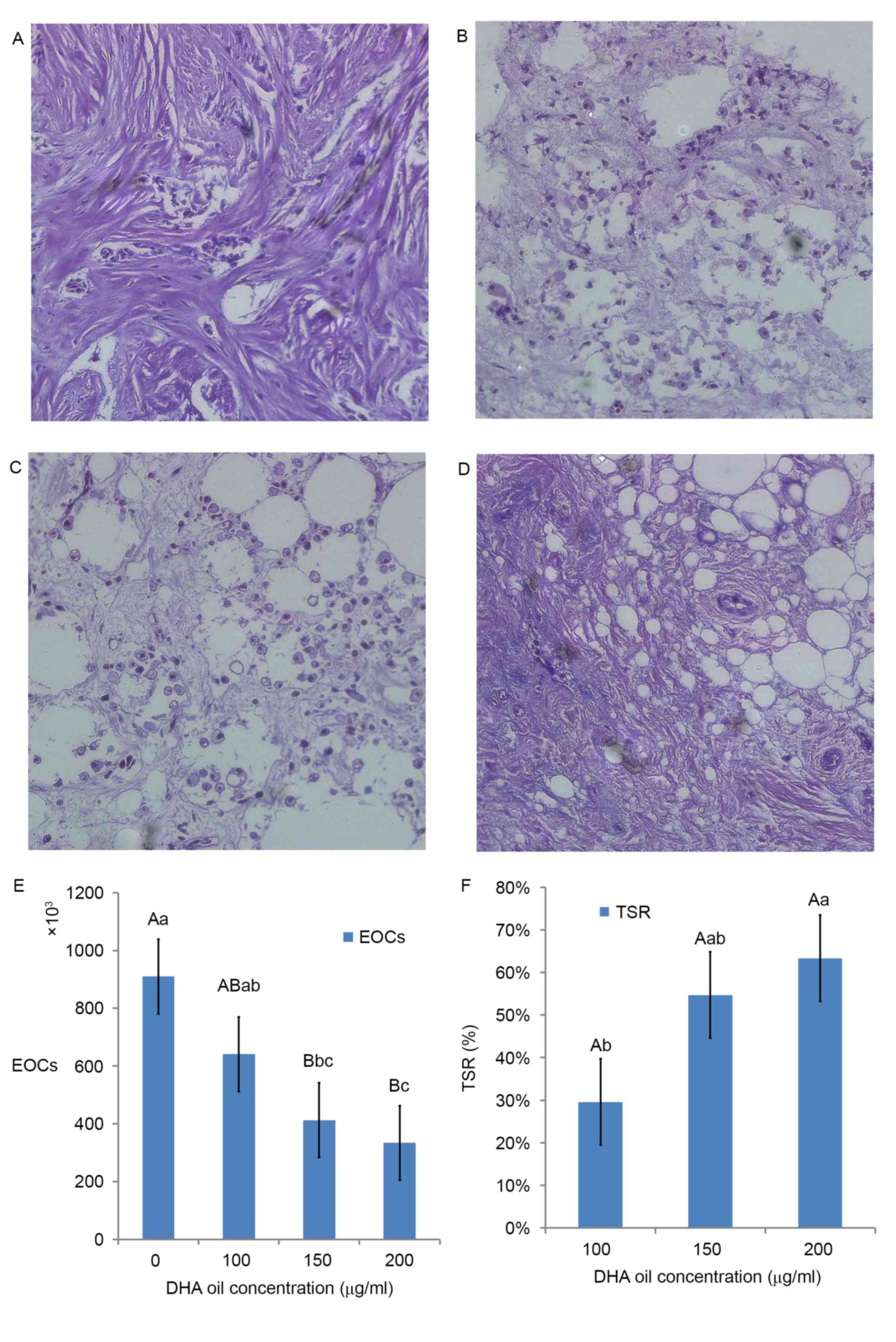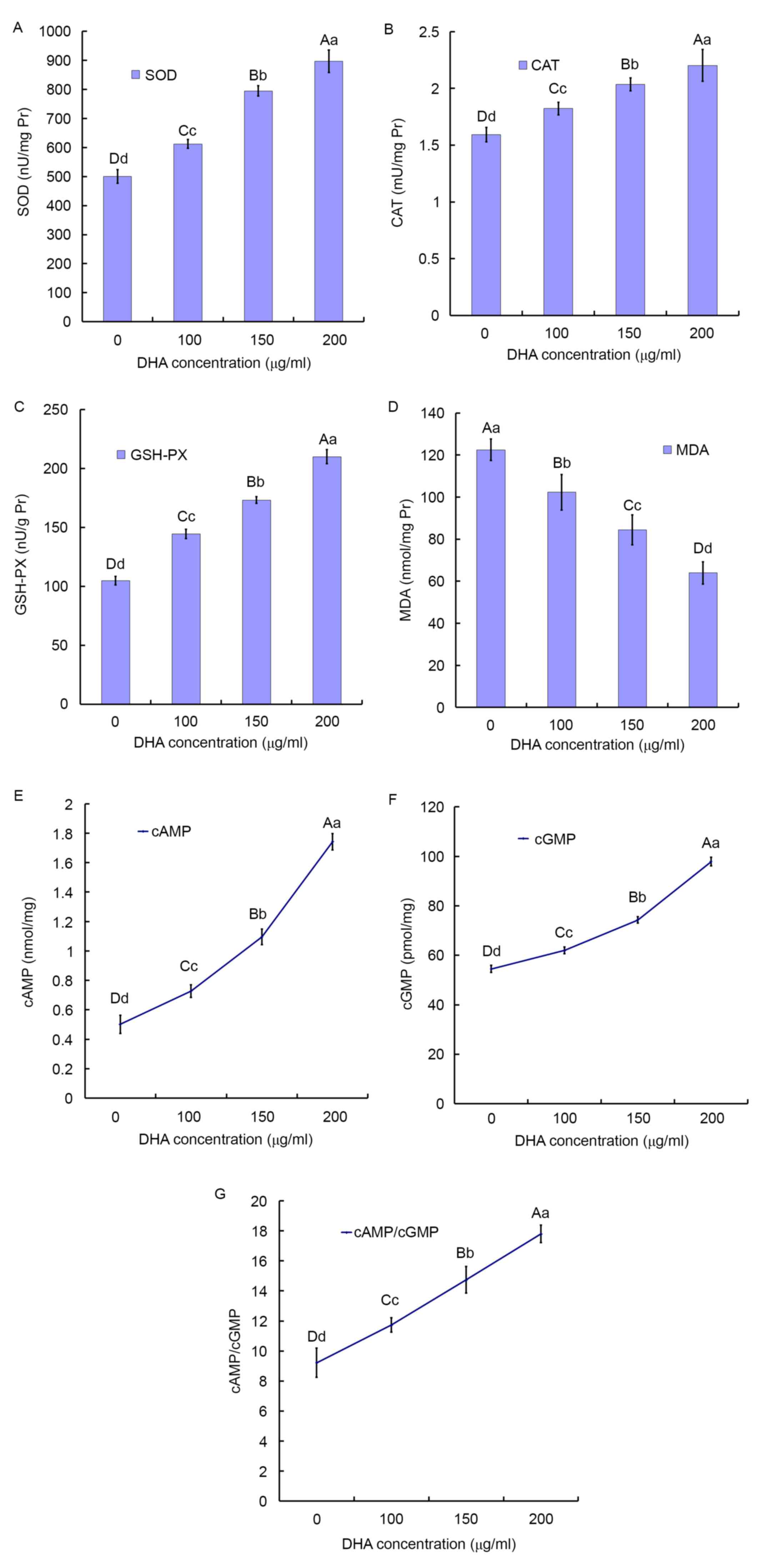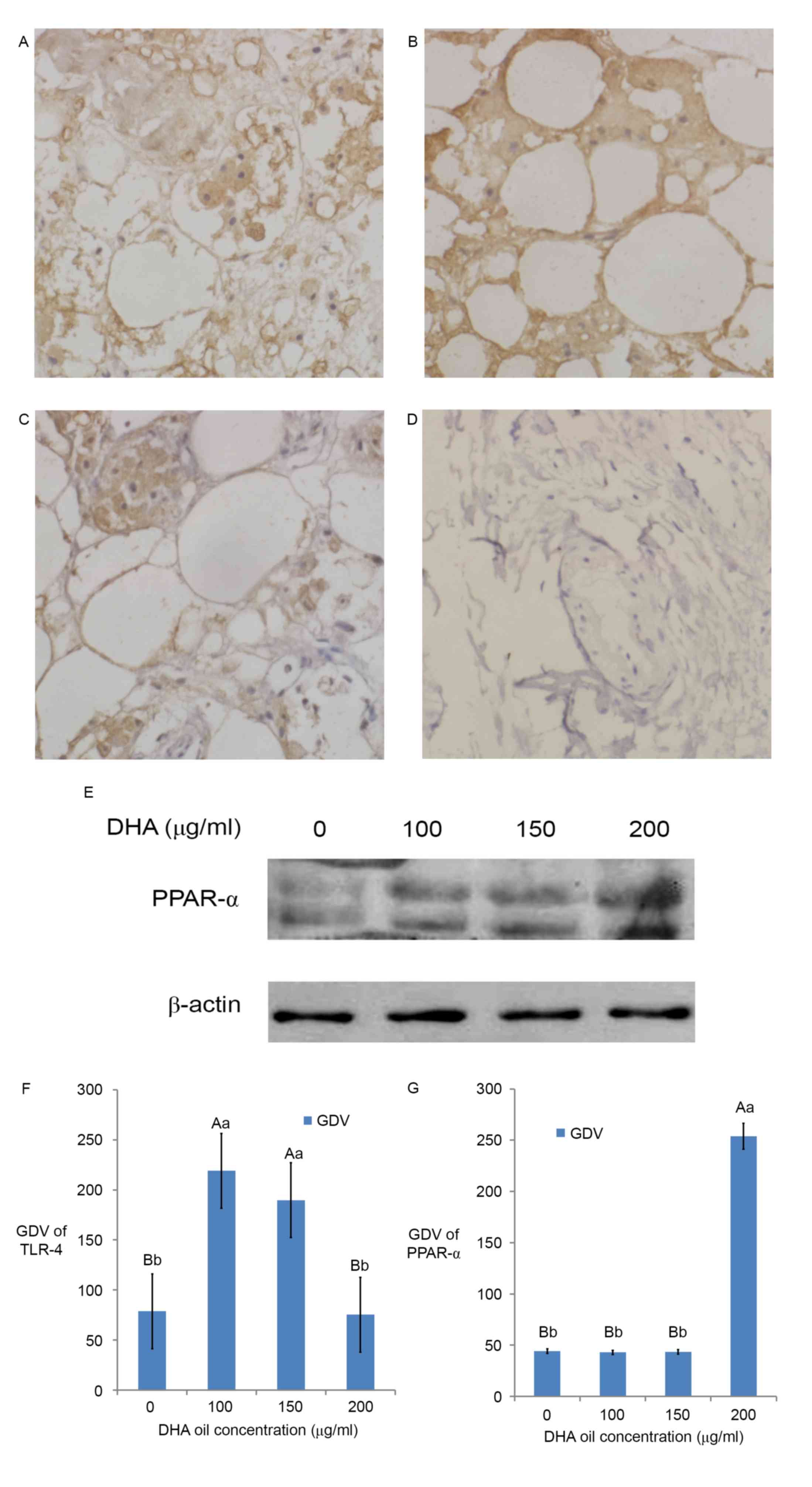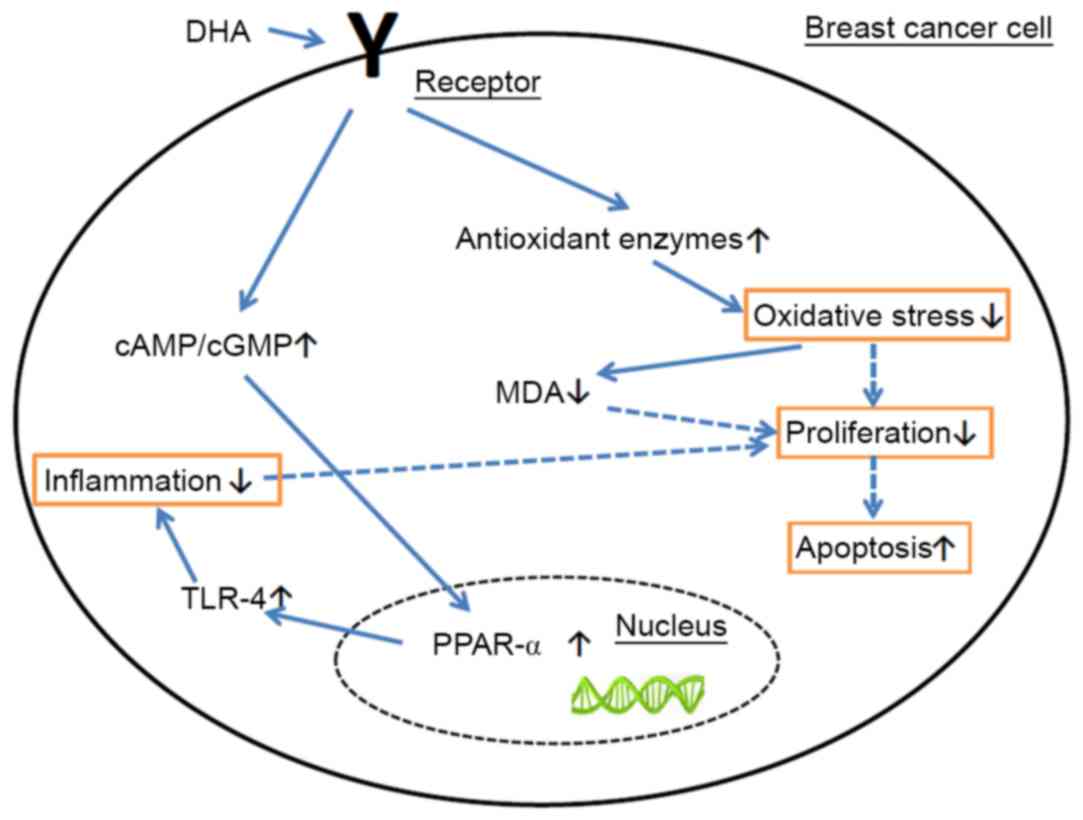DHA induces apoptosis of human malignant breast cancer tissues by the TLR‑4/PPAR‑α pathways
- Authors:
- Lijing Geng
- Wei Zhou
- Bing Liu
- Xinyun Wang
- Bo Chen
-
Affiliations: Key Laboratory of Molecular Cell Biology and New Drug Development of the Educational Department of Jinzhou Province, Food Science and Engineer College, Jinzhou Medical University, Jinzhou, Liaoning 121001, P.R. China - Published online on: December 28, 2017 https://doi.org/10.3892/ol.2017.7702
- Pages: 2967-2977
-
Copyright: © Geng et al. This is an open access article distributed under the terms of Creative Commons Attribution License.
This article is mentioned in:
Abstract
 |
 |
 |
 |
|
Meadus WJ, Turner TD, Dugan ME, Aalhus JL, Duff P, Rolland D, Uttaro B and Gibson LL: Fortification of pork loins with docosahexaenoic acid (DHA) and its effect on flavour. J Anim Sci Biotechnol. 4:462013. View Article : Google Scholar : PubMed/NCBI | |
|
Opperman M, Marais de W and Spinnler Benade AJ: Analysis of omega-3 fatty acid content of South African fish oil supplements. Cardiovasc J Afr. 22:324–329. 2011. View Article : Google Scholar : PubMed/NCBI | |
|
DeSantis C, Ma J, Bryan L and Jemal A: Breast cancer statistics, 2013. CA Cancer J Clin. 64:52–62. 2014. View Article : Google Scholar : PubMed/NCBI | |
|
Murff HJ, Shu XO, Li H, Yang G, Wu X, Cai H, Wen W, Gao YT and Zheng W: Dietary polyunsaturated fatty acids and breast cancer risk in Chinese women: A prospective cohort study. Int J Cancer. 128:1434–1441. 2011. View Article : Google Scholar : PubMed/NCBI | |
|
Blanckaert V, Kerviel V, Lépinay A, Joubert-Durigneux V, Hondermarck H and Chénais B: Docosahexaenoic acid inhibits the invasion of MDA-MB-231 breast cancer cells through upregulation of cytokeratin-1. Int J Oncol. 46:2649–2955. 2015. View Article : Google Scholar : PubMed/NCBI | |
|
Liu J and Ma DW: The role of n-3 polyunsaturated fatty acids in the prevention and treatment of breast cancer. Nutrients. 6:5184–5223. 2014. View Article : Google Scholar : PubMed/NCBI | |
|
Mouradian M, Kikawa KD, Dranka BP, Komas SM, Kalyanaraman B and Pardini RS: Docosahexaenoic acid attenuates breast cancer cell metabolism and the Warburg phenotype by targeting bioenergetic function. Mol Carcinog. 54:810–820. 2015. View Article : Google Scholar : PubMed/NCBI | |
|
Xue M, Wang Q, Zhao J, Dong L, Ge Y, Hou L, Liu Y and Zheng Z: Docosahexaenoic acid inhibited the Wnt/β-catenin pathway and suppressed breast cancer cells in vitro and in vivo. J Nutr Biochem. 25:104–110. 2014. View Article : Google Scholar : PubMed/NCBI | |
|
Rahman MM, Veigas JM, Williams PJ and Fernandes G: DHA is a more potent inhibitor of breast cancer metastasis to bone and related osteolysis than EPA. Breast Cancer Res Treat. 141:341–352. 2013. View Article : Google Scholar : PubMed/NCBI | |
|
Lijing G, Xingyuan Q, Zhuping S, Jialing G, Bing L, et al: Research progress in the tumor suppression mechanisms of marine polyunsaturated fatty acids DHA. Sci Technol Food Industry. 22:385–391. 2013. | |
|
Klaunig JE and Kamendulis LM: The role of oxidative stress in carcinogenesis. Annu Rev Pharmacol Toxicol. 44:239–267. 2004. View Article : Google Scholar : PubMed/NCBI | |
|
Khan MA, Tania M, Zhang DZ and Chen HC: Antioxidant enzymes and cancer. Chin J Cancer Res. 22:87–92. 2010. View Article : Google Scholar | |
|
Arsova-Sarafinovska Z, Eken A, Matevska N, Erdem O, Sayal A, Savaser A, Banev S, Petrovski D, Dzikova S, Georgiev V, et al: Increased oxidative/nitrosative stress and decreased antioxidant enzyme activities in prostate cancer. Clin Biochem. 42:1228–1235. 2009. View Article : Google Scholar : PubMed/NCBI | |
|
De Craemer D, Pauwels M, Hautekeete M and Roels F: Alterations of hepatocellular peroxisomes in patients with cancer. Catalase cytochemistry and morphometry. Cancer. 71:3851–3858. 1993. View Article : Google Scholar : PubMed/NCBI | |
|
Elchuri S, Oberley TD, Qi W, Eisenstein RS, Jackson Roberts L, Van Remmen H, Epstein CJ and Huang TT: CuZnSOD deficiency leads to persistent and widespread oxidative damage and hepatocarcinogenesis later in life. Oncogene. 24:367–380. 2005. View Article : Google Scholar : PubMed/NCBI | |
|
Jeon SH, Park JH and Chang SG: Expression of antioxidant enzymes (Catalase, superoxide dismutase, and glutathione peroxidase) in human bladder cancer. Korean J Urol. 48:921–926. 2007. View Article : Google Scholar | |
|
Kasapović J, Pejić S, Todorović A, Stojiljković V and Pajović SB: Antioxidant status and lipid peroxidation in the blood of breast cancer patients of different ages. Cell Biochem Funct. 26:723–730. 2008. View Article : Google Scholar : PubMed/NCBI | |
|
Sharma A, Tripathi M, Satyam A and Kumar L: Study of antioxidant levels in patients with multiple myeloma. Leuk Lymphoma. 50:809–815. 2009. View Article : Google Scholar : PubMed/NCBI | |
|
Chung-man Ho J, Zheng S, Comhair SA, Farver C and Erzurum SC: Differential expression of manganese superoxide dismutase and catalase in lung cancer. Cancer Res. 61:8578–8585. 2001.PubMed/NCBI | |
|
Khan MA, Chen HC, Wan XX, Tania M, Xu AH, Chen FZ and Zhang DZ: Regulatory effects of resveratrol on antioxidant enzymes: A mechanism of growth inhibition and apoptosis induction in cancer cells. Mol Cells. 35:219–225. 2013. View Article : Google Scholar : PubMed/NCBI | |
|
Xingyuan Q, Lijing G, Weijie C, Mengyi S, Bing L, et al: Optimized detection methods of fatty acids in the Bohai seaweed by response surface method. Feed Res. 1:65–70. 2015. | |
|
Ge M, Chi X, Zhang A, Luo G, Sun G, Xie H and Hei Z: Intestinal NF-E2-related factor-2 expression and antioxidant activity changes in rats undergoing orthotopic liver autotransplantation. Oncol Lett. 6:1307–1312. 2013. View Article : Google Scholar : PubMed/NCBI | |
|
Yagi K: Simple assay for the level of total lipid peroxides in serum or plasma. Methods Mol Biol. 108:101–106. 1998.PubMed/NCBI | |
|
Gutiérrez-Salinas J, García-Ortíz L, Morales González JA, Hernández-Rodríguez S, Ramírez-García S, Núñez-Ramos NR and Madrigal-Santillán E: In vitro effect of sodium fluoride on malondialdehyde concentration and on superoxide dismutase, catalase, and glutathione peroxidase in human erythrocytes. ScientificWorldJournal. 2013:8647182013. View Article : Google Scholar : PubMed/NCBI | |
|
Johnson K, Bruder ED and Raff H: Adrenocortical control in the neonatal rat: ACTH- and cAMP-independent corticosterone production during hypoxia. Physiol Rep. 1:e000542013. View Article : Google Scholar : PubMed/NCBI | |
|
Thumova M, Pech V, Froehlich O, Agazatian D, Wang X, Verlander JW, Kim YH and Wall SM: Pendrin protein abundance in the kidney is regulated by nitric oxide and cAMP. Am J Physiol Renal Physiol. 303:F812–F820. 2012. View Article : Google Scholar : PubMed/NCBI | |
|
Geng L and Li Q: Expression and function of heregulin-alpha and its receptors in mammary gland of mouse. Sci China Life Sci. 53:1015–1024. 2010. View Article : Google Scholar : PubMed/NCBI | |
|
Geng L, Zhou W, Qu X, Chen W, Li Y, Liu C, Sun J, Yu X, Wang H, Zhang Z, et al: Optimization of the preparation of pectin from aloe using a box-behnken design. Carbohydrate Polymers. 105:193–199. 2014. View Article : Google Scholar : PubMed/NCBI | |
|
Ghoneum MH, Badr El-Din NK, Abdel Fattah SM, Pan D and Tolentino L: Hydroferrate fluid, MRN-100, provides protection against chemical-induced gastric and esophageal cancer in Wistar rats. Int J Biol Sci. 11:295–303. 2015. View Article : Google Scholar : PubMed/NCBI | |
|
Deepalakshmi K, Mirunalini S, Krishnaveni M and Arulmozhi V: In vitro and in vivo antioxidant potentials of an ethanolic extract of Ganodermalucidum in rat mammary carcinogenesis. Chin J Nat Med. 11:621–627. 2013.PubMed/NCBI | |
|
Periyasamy K, Baskaran K, Ilakkia A, Vanitha K, Selvaraj S and Sakthisekaran D: Antitumor efficacy of tangeretin by targeting the oxidative stress mediated on 7,12-dimethylbenz (a) anthracene-induced proliferative breast cancer in Sprague-Dawley rats. Cancer Chemother Pharmacol. 75:263–272. 2015. View Article : Google Scholar : PubMed/NCBI | |
|
Giorgio M, Trinei M, Migliaccio E and Pelicci PG: Hydrogen peroxide: A metabolic by-product or a common mediator of ageing signals? Nat Rev Mol Cell Biol. 8:722–728. 2007. View Article : Google Scholar : PubMed/NCBI | |
|
Kowaltowski AJ, Castilho RF and Vercesi AE: Mitochondrial permeability transition and oxidative stress. FEBS Lett. 495:12–15. 2001. View Article : Google Scholar : PubMed/NCBI | |
|
Martinez-Useros J and Garcia-Foncillas J: Obesity and colorectal cancer: Molecular features of adipose tissue. J Transl Med. 14:212016. View Article : Google Scholar : PubMed/NCBI | |
|
Piazza GA, Thompson WJ, Pamukcu R, Alila HW, Whitehead CM, et al: Exisulind, a novel proapoptotic drug, inhibits rat urinary bladder tumorigenesis. Cancer Res. 2001.61:3961–3968. PubMed/NCBI | |
|
Kool M, de Haas M, Scheffer GL, Scheper RJ, van Eijk MJ, et al: Analysis of expression of cMOAT (MRP2), MRP3, MRP4, and MRP5, homologues of the multidrug resistance-associated protein gene (MRP1), in human cancer cell lines. Cancer Res. 1997.57:3537–3547. PubMed/NCBI | |
|
Drees M, Zimmermann R and Eisenbrand G.: 3′,5′-Cyclic nucleotide phosphodiesterase in tumor cells as potential target for tumor growth inhibition. Cancer Res. 1993.53:3058–3061. PubMed/NCBI | |
|
Ciardiello F, Pepe S, Bianco C, Baldassarre G, Ruggiero A, et al: Down-regulation of RI alpha subunit of cAMP-dependent protein kinase induces growth inhibition of human mammary epithelial cells transformed by c-Ha-ras and c-erbB-2 proto-oncogenes. Int. J. Cancer. 1993.53:438–443. View Article : Google Scholar : PubMed/NCBI | |
|
Singer AL, Sherwin RP, Dunn AS and Appleman M.M.: Cyclic nucleotide phosphodiesterases in neoplastic and nonneoplastic human mammary tissues. Cancer Res. 1976.36:60–66. PubMed/NCBI | |
|
Cohen LA, Straka D and Chan PC: Cyclic nucleotide phosphodiesterase activity in normal and neoplastic rat mammary cells grown in monolayer culture. Cancer Res. 1976.36:2007–2012. PubMed/NCBI | |
|
Tinsley H.N..Gary B.D..Keeton A.B..Zhang W..Abadi A.H..Reynolds R.C..Piazza G.A.: Sulindac sulfide selectively inhibits growth and induces apoptosis of human breast tumor cells by phosphodiesterase 5 inhibition, elevation of cyclic GMP, and activation of protein kinase G. Mol. Cancer Ther. 2009.8:3331–3340. View Article : Google Scholar : PubMed/NCBI | |
|
Deguchi A and Thompson WJ: Weinstein IB Activation of protein kinase G is sufficient to induce apoptosis and inhibit cell migration in colon cancer cells. Cancer Res. 2004.64:3966–3973. View Article : Google Scholar : PubMed/NCBI | |
|
Carlson CC, Smithers SL, Yeh KA, Burnham LL and Dransfield DT: Protein kinase A regulatory subunits in colon cancer. Neoplasia. 1999.1:373–378. View Article : Google Scholar : PubMed/NCBI | |
|
Tinsley H.N..Gary B.D..Keeton A.B..Zhang W..Abadi A.H..Reynolds R.C..Piazza G.A.: Sulindac sulfide selectively inhibits growth and induces apoptosis of human breast tumor cells by phosphodiesterase 5 inhibition, elevation of cyclic GMP, and activation of protein kinase G. Mol. Cancer Ther. 2009.8:3331–3340. View Article : Google Scholar : PubMed/NCBI | |
|
DeRubertis FR and Craven PA: Sequential alterations in the hepatic content and metabolism of cyclic AMP and cyclic GMP induced by DL-ethionine: Evidence for malignant transformation of liver with a sustained increase in cyclic AMP. Metabolism. 1976.25:1611–1625. View Article : Google Scholar : PubMed/NCBI | |
|
Lerner A and Epstein PM: Cyclic nucleotide phosphodiesterases as targets for treatment of haematological malignancies. Biochem. J. 2006.393:21–41. View Article : Google Scholar : PubMed/NCBI | |
|
Zhang L, Murray F, Zahno A, Kanter JR, Chou D, et al: Cyclic nucleotide phosphodiesterase profiling reveals increased expression of phosphodiesterase 7B in chronic lymphocytic leukemia. Proc. Natl. Acad. Sci. USA. 2008; 105:pp. 19532–19537. View Article : Google Scholar | |
|
Marko D, Pahlke G, Merz KH and Eisenbrand G: Cyclic 3′,5′-nucleotide phosphodiesterases: Potential targets for anticancer therapy. Chem. Res. Toxicol. 2000.13:944–948. View Article : Google Scholar : PubMed/NCBI | |
|
Aleksijevic A, Lang JM, Giron C, Stoclet JC, Mayer S, et al: Alterations of peripheral blood lymphocyte cyclic AMP and cyclic GMP in untreated patients with hodgkin's disease. Clin. Immunol. Immunopathol. 1983.26:398–405. View Article : Google Scholar : PubMed/NCBI | |
|
Aleksijevic A, Lugnier C, Giron C, Mayer S, Stoclet JC, et al: Cyclic AMP and cyclic GMP phosphodiesterase activities in Hodgkin's disease lymphocytes. Int. J. Immunopharmacol. 1987.9:525–531. View Article : Google Scholar : PubMed/NCBI | |
|
Heinonen PK and Metsa-Ketela T: Prostanoids and cyclic nucleotides in malignant and benign ovarian tumors. Med. Oncol. Tumor Pharmacother. 1988.5:11–15. PubMed/NCBI | |
|
Pertuit M, Barlier A, Enjalbert A and Gérard C: Signalling pathway alterations in pituitary adenomas: Involvement of Gsalpha, cAMP and mitogen-activated protein kinases. J. Neuroendocrinol. 2009.21:869–877. View Article : Google Scholar : PubMed/NCBI | |
|
Michalides R..Griekspoor A..Balkenende A..Verwoerd D..Janssen L..Jalink K..Floore A..Velds A..van't Veer L..Neefjes J.: Tamoxifen resistance by a conformational arrest of the estrogen receptor alpha after PKA activation in breast cancer. Cancer Cell. 2004.5:597–605. View Article : Google Scholar : PubMed/NCBI | |
|
Shacter E and Weitzman SA: Chronic inflammation and cancer. Oncology (Williston Park). 16:217–26, 229–232. 2002.PubMed/NCBI | |
|
Khansari N, Shakiba Y and Mahmoudi M: Chronic inflammation and oxidative stress as a major cause of age-related diseases and cancer. Recent Pat Inflamm Allergy Drug Discov. 3:73–80. 2009. View Article : Google Scholar : PubMed/NCBI | |
|
Toyoshi I, Noriyuki S and Yasutaka M: Bilirubin as an important physiological modulator of oxidative stress and chronic inflammation in metabolic syndrome and diabetes: A new aspect on old molecule. Diabetology International. 7:338–341. 2016. View Article : Google Scholar | |
|
Ahmed A, Redmond HP and Wang JH: Links between Toll-like receptor 4 and breast cancer. Oncoimmunology. 2:e229452013. View Article : Google Scholar : PubMed/NCBI | |
|
Ahmed A, Wang JH and Redmond HP: Silencing of TLR4 increases tumor progression and lung metastasis in a murine model of breast cancer. Ann Surg Oncol. 20 Suppl 3:S389–S396. 2013. View Article : Google Scholar : PubMed/NCBI | |
|
Mai CW, Kang YB and Pichika MR: Should a Toll-like receptor 4 (TLR-4) agonist or antagonist be designed to treat cancer? TLR-4: Its expression and effects in the ten most common cancers. Onco Targets Ther. 6:1573–1587. 2013.PubMed/NCBI | |
|
Ghochikyan A, Pichugin A, Bagaev A, Davtyan A, Hovakimyan A, Tukhvatulin A, Davtyan H, Shcheblyakov D, Logunov D, Chulkina M, et al: Targeting TLR-4 with a novel pharmaceutical grade plant derived agonist, Immunomax®, as a therapeutic strategy for metastatic breast cancer. J Transl Med. 12:3222014. View Article : Google Scholar : PubMed/NCBI | |
|
Yang H, Wang B, Wang T, Xu L, He C, Wen H, Yan J, Su H and Zhu X: Toll-like receptor 4 prompts human breast cancer cells invasiveness via lipopolysaccharide stimulation and is overexpressed in patients with lymph node metastasis. PLoS One. 9:e1099802014. View Article : Google Scholar : PubMed/NCBI | |
|
Delerive P, De Bosscher K, Besnard S, VandenBerghe W, Peters JM, Gonzalez FJ, Fruchart JC, Tedgui A, Haegeman G and Staels B: Peroxisome proliferator-activated receptor a negatively regulates the vascular inflammatory gene response by negative cross-talk with transcription factors NF-kappaB and AP-1. J Biol Chem. 274:32048–32054. 1999. View Article : Google Scholar : PubMed/NCBI | |
|
Peters JM, Shah YM and Gonzalez FJ: The role of peroxisome proliferator-activated receptors in carcinogenesis and chemoprevention. Nat Rev Cancer. 12:181–195. 2012. View Article : Google Scholar : PubMed/NCBI | |
|
Takeda S, Ikeda E, Su S, Harada M, Okazaki H, Yoshioka Y, Nishimura H, Ishii H, Kakizoe K, Taniguchi A, et al: Δ (9)-THC modulation of fatty acid 2-hydroxylase (FA2H) gene expression: Possible involvement of induced levels of PPARα in MDA-MB-231 breast cancer cells. Toxicology. 326:18–24. 2014. View Article : Google Scholar : PubMed/NCBI | |
|
Schoonjans K, Staels B and Auwerx J: The peroxisome proliferator activated receptors (PPARS) and their effects on lipid metabolism and adipocyte differentiation. Biochim Biophys Acta. 1302:93–109. 1996. View Article : Google Scholar : PubMed/NCBI | |
|
Desvergne B and Wahli W: Peroxisome proliferator-activated receptors: Nuclear control of metabolism. Endocr Rev. 20:649–688. 1999. View Article : Google Scholar : PubMed/NCBI | |
|
Shigeto T, Yokoyama Y, Xin B and Mizunuma H: Peroxisome proliferator-activated receptor alpha and gamma ligands inhibit the growth of human ovarian cancer. Oncol Rep. 18:833–840. 2007.PubMed/NCBI | |
|
Drukala J, Urbanska K, Wilk A, Grabacka M, Wybieralska E, Del Valle L, Madeja Z and Reiss K: ROS accumulation and IGF-IR inhibition contribute to fenofibrate/PPARalpha-mediated inhibition of glioma cell motility in vitro. Mol Cancer. 9:1592010. View Article : Google Scholar : PubMed/NCBI | |
|
Grabacka M, Plonka PM, Urbanska K and Reiss K: Peroxisome proliferator-activated receptor alpha activation decreases metastatic potential of melanoma cells in vitro via down-regulation of Akt. Clin Cancer Res. 12:3028–3036. 2006. View Article : Google Scholar : PubMed/NCBI | |
|
Zhou J, Zhang S, Xue J, Avery J, Wu J, Lind SE and Ding WQ: Activation of peroxisome proliferator-activated receptor α (PPARα) suppresses hypoxia-inducible factor-1α (HIF-1α) signaling in cancer cells. J Biol Chem. 287:35161–35169. 2012. View Article : Google Scholar : PubMed/NCBI | |
|
Yessoufou A1, Atègbo JM, Attakpa E, Hichami A, Moutairou K, Dramane KL and Khan NA: Peroxisome proliferator-activated receptor-alpha modulates insulin gene transcription factors and inflammation in adipose tissues in mice. Mol Cell Biochem. 323:101–111. 2009. View Article : Google Scholar : PubMed/NCBI |










